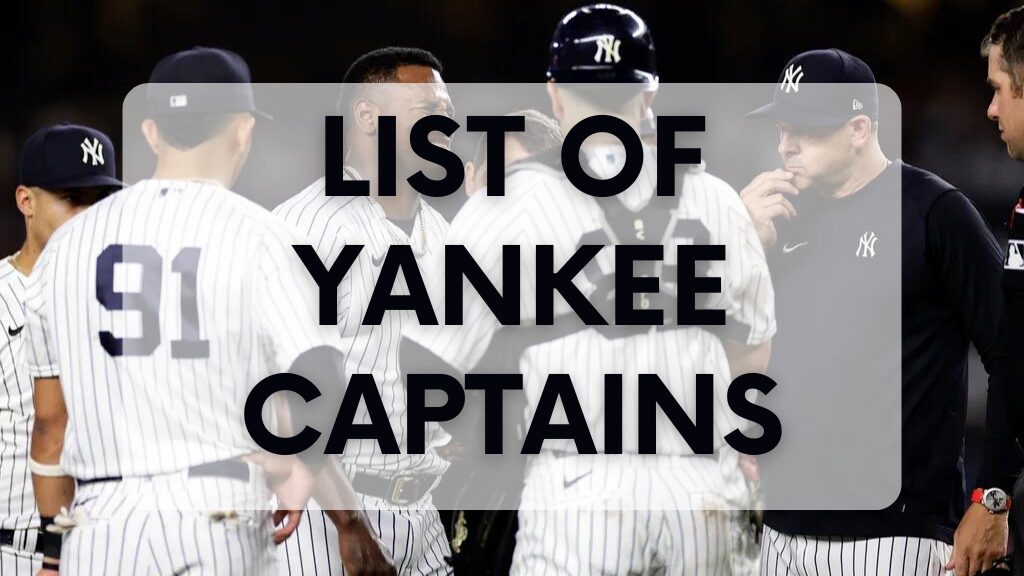The New York Yankees hold one of the richest histories in Major League Baseball, defined not only by championships and legendary players but also by the leaders chosen to wear the captain’s title. When fans search for the List of Yankee Captains, they are diving into a tradition that represents honor, leadership, and responsibility within one of the most iconic franchises in sports. The Yankees do not appoint captains lightly, and the men who have carried that role have been central figures in shaping both the culture of the clubhouse and the identity of the team on the field. From the early 20th century pioneers to modern-day legends, the story of Yankee captains is one of resilience, talent, and enduring influence.
The Early Era of Yankee Leadership
When the Yankees first began to emerge as a powerhouse in baseball, the concept of a team captain was different from how it is viewed today. Early captains often served as liaisons between the manager and the players, ensuring discipline and strategy were upheld on the field. Some of these early leaders were not the most celebrated stars statistically, but their influence in uniting the team was undeniable. This period laid the foundation for what being a Yankee captain would come to represent a position not given purely on talent, but on respect and leadership qualities.
The Rise of Iconic Captains in the 1920s and 1930s
The 1920s marked a turning point in Yankees history as Babe Ruth and Lou Gehrig began transforming the club into a dynasty. While Ruth was the face of baseball, it was Lou Gehrig who eventually earned the captaincy in 1935. His appointment was symbolic, as Gehrig embodied the spirit of durability and quiet strength. Known as the “Iron Horse,” he redefined what leadership meant for the Yankees. His humility, sportsmanship, and consistency made him a role model, and his battle with ALS further solidified his legend. Gehrig’s role as captain during this golden age of Yankees baseball created a standard for future leaders, proving that the captain’s title was not just honorary but also deeply connected to character.
Post-Gehrig Captains and a Changing Role
After Gehrig, the Yankees continued to assign the captaincy to players who embodied leadership and integrity. This period, stretching through the mid-20th century, was one where the captaincy sometimes went unfilled, which added to its prestige. The Yankees’ dominance during this era with players like Joe DiMaggio, Phil Rizzuto, and Yogi Berra leading in different ways demonstrated that while not every leader wore the title officially, the tradition of having a guiding figure was still alive. When a player was named captain, it was seen as a gesture of trust from both the organization and teammates.
Thurman Munson: A New Definition of Captain
The appointment of Thurman Munson as captain in 1976 marked a new chapter. Munson was the first Yankee to hold the title since Gehrig, and he redefined it for the modern age. A gritty catcher with a fiery personality, Munson was known for his toughness and work ethic. His leadership helped the Yankees return to prominence, culminating in back-to-back World Series championships in 1977 and 1978. Munson’s tragic death in a plane crash in 1979 cemented his place in Yankees lore. His captaincy is often remembered as one of the most emotional in franchise history, showing how the role of captain went beyond statistics and into the realm of legacy.
The 1980s and the Continuation of Leadership
Following Munson, the Yankees once again looked to players who could carry the weight of leadership. Graig Nettles briefly served as captain, and later, Don Mattingly took on the title in 1991. Mattingly’s captaincy came during a transitional period for the Yankees when championships were scarce, but his professionalism and dedication kept the team competitive. Known as “Donnie Baseball,” he was admired by teammates and fans alike for his commitment, even though his career was cut short by injuries. His role demonstrated that a captain’s impact is measured not only in championships but in setting an example during challenging times.
Derek Jeter and the Modern Golden Age
In 2003, Derek Jeter was officially named captain, a title he would hold until his retirement in 2014. Jeter’s era as captain is often considered the most iconic since Gehrig. With five World Series championships and countless clutch performances, Jeter epitomized what it meant to be a Yankee. His leadership style was calm, steady, and focused on leading by example. Jeter’s captaincy coincided with the Yankees’ modern dynasty years, and he became a symbol of class and consistency for the franchise. For many fans, the Yankee Captains feels incomplete without placing Jeter at the very heart of it. His speeches, his postseason heroics, and his loyalty to the Yankees defined a generation of baseball fans.
Aaron Judge and the Present Era
After Jeter’s retirement, the captaincy remained vacant for nearly a decade. The Yankees waited for the right leader, someone who could carry the weight of the franchise with honor. That moment came in 2022 when Aaron Judge, fresh off an MVP season and a record-breaking 62 home runs, was named captain. Judge’s appointment reignited the tradition, reminding fans of the responsibility that comes with the title. His towering presence, dedication to his teammates, and ability to thrive under pressure made him the natural choice. As the current captain, Judge carries the legacy of those before him while also shaping the future of what the title means in today’s game.
The Significance of the Captaincy Tradition
The captaincy of the Yankees is unlike that of most other teams in professional sports. Not every roster needs a captain, but for the Yankees, the tradition is sacred. Being named captain is not only a reflection of performance but also of trust, character, and leadership. It is a position that connects past and present, creating a bridge between generations of fans and players. The List of Yankee Captains is relatively short compared to the team’s long history, which makes the honor even more significant. Each captain has left a mark, contributing to the Yankees’ identity as more than just a baseball team; they are a symbol of excellence and tradition.
How the Captaincy Impacts the Team Culture
One of the most fascinating aspects of the Yankees’ approach to captains is how it influences team culture. Players often describe the presence of a captain as a stabilizing force, especially during times of adversity. A captain embodies accountability, representing the players to management and the organization to the fans. For younger players, the captain serves as a role model, someone to emulate both on and off the field. This ripple effect ensures that the influence of the captain extends far beyond the dugout.
Legacy and Lasting Impact of Yankee Captains
When looking back at the history of Yankee captains, it becomes clear that their legacies are intertwined with the team’s broader success. From Gehrig’s courage to Munson’s grit, from Mattingly’s loyalty to Jeter’s consistency, and now with Judge’s emerging leadership, each captain tells part of the Yankees’ story. They represent different eras but share common values of leadership, dedication, and excellence. Fans continue to celebrate their contributions, ensuring that the role of Yankee captain remains one of the most revered honors in all of sports.
Conclusion
The history of the New York Yankees is filled with remarkable achievements, but the tradition of its captains stands out as a unique symbol of leadership and respect. Exploring the List of Yankee Captains is like tracing the evolution of the franchise itself, from the early pioneers to modern legends. Each captain has carried the weight of expectations while shaping the team’s culture and inspiring future generations. As Aaron Judge continues the legacy today, the captaincy remains a living tradition, one that binds the Yankees’ past, present, and future together in the story of baseball’s most storied franchise.
FAQs
Who was the first captain of the Yankees?
The first recognized captain of the Yankees was Clark Griffith in the early 20th century, serving as both a leader on the mound and in the clubhouse.
Why was Lou Gehrig considered the most respected captain?
Lou Gehrig earned immense respect not only for his durability and talent but also for his humility and courage, particularly during his battle with ALS.
How long did Derek Jeter serve as captain?
Derek Jeter served as captain from 2003 until his retirement in 2014, making him one of the longest-tenured captains in franchise history.
Who is the current Yankees captain?
Aaron Judge was named the Yankees’ captain in 2022, becoming the first to hold the title since Derek Jeter.
Do all teams in baseball have captains?
No, most Major League Baseball teams do not designate captains, which makes the Yankees’ tradition especially meaningful and unique.





